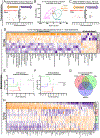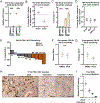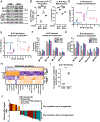MYC is a regulator of androgen receptor inhibition-induced metabolic requirements in prostate cancer
- PMID: 37815914
- PMCID: PMC11972006
- DOI: 10.1016/j.celrep.2023.113221
MYC is a regulator of androgen receptor inhibition-induced metabolic requirements in prostate cancer
Abstract
Advanced prostate cancers are treated with therapies targeting the androgen receptor (AR) signaling pathway. While many tumors initially respond to AR inhibition, nearly all develop resistance. It is critical to understand how prostate tumor cells respond to AR inhibition in order to exploit therapy-induced phenotypes prior to the outgrowth of treatment-resistant disease. Here, we comprehensively characterize the effects of AR blockade on prostate cancer metabolism using transcriptomics, metabolomics, and bioenergetics approaches. The metabolic response to AR inhibition is defined by reduced glycolysis, robust elongation of mitochondria, and increased reliance on mitochondrial oxidative metabolism. We establish DRP1 activity and MYC signaling as mediators of AR-blockade-induced metabolic phenotypes. Rescuing DRP1 phosphorylation after AR inhibition restores mitochondrial fission, while rescuing MYC restores glycolytic activity and prevents sensitivity to complex I inhibition. Our study provides insight into the regulation of treatment-induced metabolic phenotypes and vulnerabilities in prostate cancer.
Keywords: CP: Cancer; CP: Metabolism.
Copyright © 2023 The Author(s). Published by Elsevier Inc. All rights reserved.
Conflict of interest statement
Declaration of interests P.C.B. sits on the scientific advisory boards of Sage Bionetworks, BioSymetrics, Inc., and Intersect Diagnostics, Inc.
Figures







References
Publication types
MeSH terms
Substances
Grants and funding
- R01 CA237191/CA/NCI NIH HHS/United States
- U2C DK129496/DK/NIDDK NIH HHS/United States
- P50 CA092131/CA/NCI NIH HHS/United States
- T32 CA009056/CA/NCI NIH HHS/United States
- U01 CA224044/CA/NCI NIH HHS/United States
- UL1 TR001881/TR/NCATS NIH HHS/United States
- TL1 DK132768/DK/NIDDK NIH HHS/United States
- T32 GM008042/GM/NIGMS NIH HHS/United States
- P30 DK041301/DK/NIDDK NIH HHS/United States
- T32 GM007185/GM/NIGMS NIH HHS/United States
- OT2 OD030544/OD/NIH HHS/United States
- R35 GM138003/GM/NIGMS NIH HHS/United States
- U2C DK119886/DK/NIDDK NIH HHS/United States
LinkOut - more resources
Full Text Sources
Medical
Molecular Biology Databases
Research Materials
Miscellaneous

